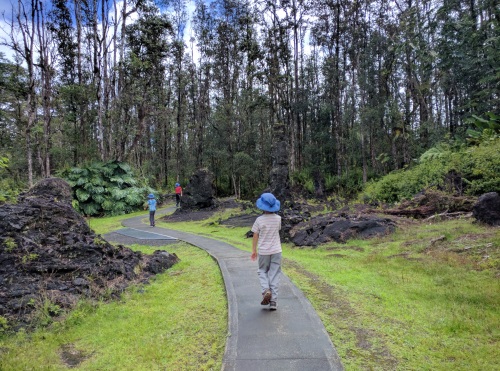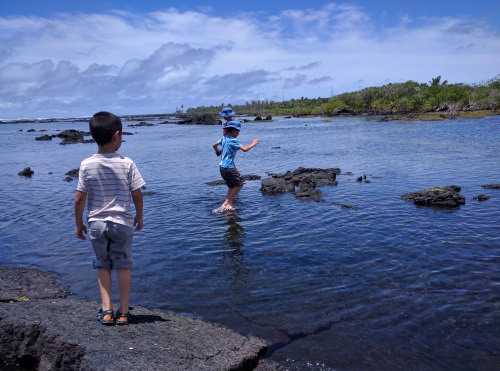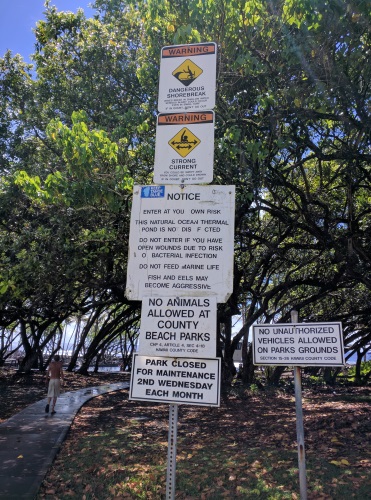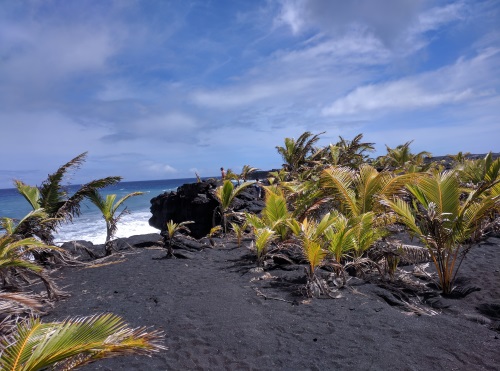The Road to Puna
The Road to Puna (also known as Kalapana-Kapoho Road) is lined with many tree canopies. The winding road makes its way mostly along the coast with frequent views of waves crashing along the shore.
Lava Trees State Monument
Since our hike to see the lava falling into the ocean did not start until 3pm, we started our day on the Road to Puna (Hwy 130 to 137 until the end of 137). This road took us by Lava Trees State Monument, where a short 0.7 mile loop allowed us to walk by trees surrounded by hot lava many years ago. As the lava receded, the lava surrounding the tree stayed, forming pillars of lava standing around a hollowed tree. The tree inside eventually combusted leaving the hollow in the core of these lava tree pillars. There were at least half a dozen of these pillars surrounded by a colorful, moist rainforest. Near the entrance there is a fence around a fissure that seems to run the length of the park. The entrance to this park was free of charge and parking was plentiful during our visit.
 Lava pillars formed around standing trees in Lava Trees State Monument, Big Island, HI
Lava pillars formed around standing trees in Lava Trees State Monument, Big Island, HI
**** UPDATE: The eruption of 2018 may have affected this area. As change is inevitable with volcanoes, please check the Volcanoes Visitor Center or website for updated information. ****
| Features: | Short walk beside a fissure with several trees enveloped by lava while still standing, forming pillars of lava |
|---|---|
| Our Hike: | 0.7 mile loop beside lava covered tree pillars |
| Directions: | Off Pahoa-Pohoiki Road (Highway 132), 2.7 miles southeast of Pahoa. |
| Fee: | Free |
Kapoho Tide Pools
Our next stop was at the Kapoho Tide pools. It was about a half mile walk in through neighbourhood to get to the tide pools. The tide pools are connected via a network of sharp black lava rocks with small trees growing on it. We were glad we had brought water footwear here, though the flip flops we had were less than ideal. Perhaps water shoes would have been a better idea.
 Rock hopping at Kapoho Tide Pools, Big Island, HI
Rock hopping at Kapoho Tide Pools, Big Island, HI
The tide pools consisted of lots of colorful baby fish in slow moving clear waters, confirming a sign we saw at the entrance stating that it was a nursery for fish. We spent a couple of hours here, while boys hopped from one rock island to another through shallow waters avoiding fissures just below the water surface, looking for colorful fish. We saw a black and white eel, some grey and yellow striped fish and some black fish. This was the first time we've seen fish in a tide pool. Our previous experiences with tide pools consisted of colorful sea urchins and seastars, which though beautiful, is not on the active moving side. We didn't bring equipment to snorkel, but saw many snorkelers. We are on the cautious side, so strong ripples in the water makes us nervous. We didn't bring equipment to snorkel, but saw many snorkelers. We are on the cautious side, so strong ripples in the water makes us nervous.
***UPDATE*** I recently read a concerning water quality report of these tide pools dated 2014. Apparently the bacteria counts at these tide pools were higher than the allowable limits. You may want to reconsider your visit here or research further to see if the issue has been rectified. Our experience at these tide pools were ignorantly blissful and am happy to report we did not have any post-visit health issues. ********
| Features: | Fun, wet, (sharp) rock island hopping to spot colorful baby fishes. |
|---|---|
| Fee: | Free |
| Don't Forget: | ***Check water quality reports*** for the area, water shoes, sunscreen, hat |
| Parking: | outside a neighbourhood area where coconut trees lined the street |
Ahalanui Hot Pond
This is where a hot spring mixes with ocean water near the ocean’s edge. The hot springs area seem to be protected from the ocean by a rock wall on most sides. We opted not to jump in.
 Warning Sign at Ahalanui Hot Ponds, Big Island, HI
Warning Sign at Ahalanui Hot Ponds, Big Island, HI
Being somewhat of a germaphobe and not much of a water-lover, the sign at the entrance was enough to put me off. We spent time around the coconut grove with the boys brainstorming how to get coconuts down from the trees.
New land at the end of Kalapana-Kapoho Road
We needed to kill about an hour before the hiking trail to the Lava opened at 3pm. We drove to the end of Hwy 137 by accident and came upon a small area with some island-style shops and restaurants. Just before it, there was a decomposing lava bed that went on for probably a mile to the ocean. Near the ocean, there was a young coconut tree grove taking root on the developing black sand beach. I wonder if trees and their root systems help break down the hard lava rock into fertile soil. We watched waves crash into the black lava cliffs here while the boys explored the coconut trees.
 A young coconut grove taking root at the new land at the end of Kapoho-Kalapana Rd, Big Island, HI
A young coconut grove taking root at the new land at the end of Kapoho-Kalapana Rd, Big Island, HI
The boys saw the different stages of a coconut tree life cycle. They were excited to see how a coconut tree started life. We found a foot high little tree sprouted from a dried coconut. We were surprised to see that the plant hadn't taken root into the ground yet at that point. The boys noted that this little plant is self sufficient (except for sunlight and water) using only it's mother coconut, at least up until this point. I love it when nature provides a spontaneous Biology lesson.
More Hawaii Travel Ideas More U.S.A. Travel Ideas More Worldwide Travel Ideas
